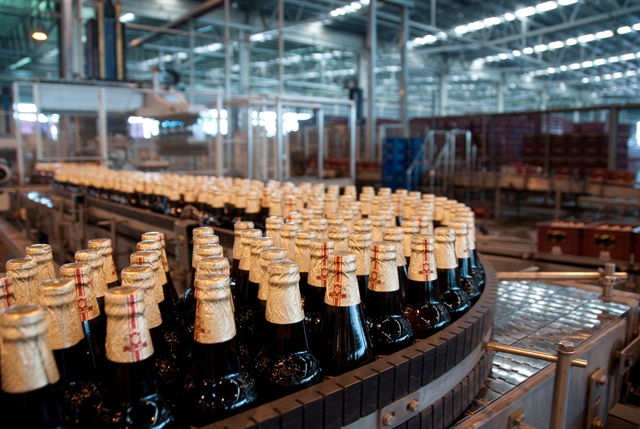 Economy
Economy


|
| Habeco's beer production line in Hà Nội City. Photo habeco.com.vn |
HÀ NỘI — Despite the positive business results in the first quarter of 2021, the beverage industry still has to face more challenges in the near future.
In May some provinces imposed social distancing measures to contain the new wave of COVID-19, including restrictions in gatherings and dining out.
This led to the index of industrial production (IIP) of the beverage industry to fall by 0.5 per cent month-on-month in May. However, the index increased 12.8 per cent over the year in the first five months of 2021, while the IIP declined 14.6 per cent in the same period last year. Beer output was more than 1.7 billion litres, up 11.7 per compared to the first five months of last year.
Saigon Alcohol Beer and Beverage Corporation (Sabeco, SAB), one of the leading companies in producing beer, reported a significant improvement. Its financial results showed that as of March 31, the company’s net revenue rose 19 per cent year-on-year to more than VNĐ5.86 trillion (US$253.6 million), resulting in a gain of 38 per cent in profit after tax to VNĐ986.2 billion.
At this year’s General Meeting of Shareholders, the company passed the business plan with a target of nearly VNĐ33.5 trillion in net revenue and nearly VNĐ5.3 trillion in profit. According to this plan, Sabeco has accomplished 17.5 per cent of the revenue plan and 18.6 per cent of the profit plan.
Similarly, Hanoi Beer Alcohol and Beverage Joint Stock Corporation (Habeco, BHN), another big beer producer in Việt Nam, also recorded a good performance in the first quarter.
In its first quarter’s financial statement, Habeco said its revenue reached nearly VNĐ1.4 trillion, up 78 per cent over the same period of last year. Consequently, the company posted a profit after tax of VNĐ47.6 billion while it had lost VNĐ98.3 billion last year.
With this year’s target of nearly VNĐ5.4 trillion in net revenue and VNĐ255 billion in profit after tax, Habeco has completed 25.5 per cent and 19 per cent of its plan, respectively.
On the stock market, there have been reductions since the beginning of the year. Even though summer is a perfect season for beverage stocks to reverse course, it is difficult to witness a positive break through.
SAB shares closed last Friday at VNĐ171,200 per share, down 4.3 per cent compared to April and 16.5 per cent since the beginning of the year.
Meanwhile, BHN shares were traded at VNĐ64,000 per share on the last trading day of the week, down 16.3 per cent compared to earlier this year.
Stocks of SAB and BHN’s subsidiaries reported a similar trend. For example, Ha Noi Beer Trading JSC (HAT) fell 17.4 per cent, and Ha Noi - Nam Dinh Beer JSC (BBM) down 17.3 per cent.
On the contrary, investors are looking at companies producing soft drinks, mineral water, healthy drinks because these products are not affected by Decree No. 100/2019 (on administrative penalties for alcohol users driving traffic).
Sanna Khanh Hoa Beverage JSC (SKN) shares, which listed on UPCOM, surged 101 per cent since the beginning of the year, rising from VNĐ9,200 to VNĐ18,500.
In 2021, the company will build a Sanna beverage factory in Sông Cầu Industrial Complex with a capacity of 5,000 products per hour. The goal of the project is to use good quality groundwater with large reserves, to reduce the cost of transporting products from factory to markets.
Khánh Hòa Sanest Beverage JSC shares (SKH) posted more modest growth, up 11 per cent for the year, from VNĐ20,900 to VNĐ23,200 last Friday.
With the current developments of the pandemic, the expert team of SSI Research cautiously forecast that the recovery of the whole industry will be slow, and demand will only recover in 2022. For the beer industry, besides the epidemic, the price of raw materials may affect consumption demand and product prices.
The lack of tourists is also affecting the industry products’ consumption. VNS




